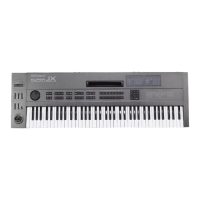Manual Version 3.21
Page. 17 of 73
4.5 EDIT PATCH PARAMETERS
The Tones and Patch Memories written to the JX-10’s internal memory or to the cartridge memory can be edited to
your taste. This editing does not automatically rewrite the previous data. To write the edited data, execute the
WRITE procedure (See page 30)
a. Editing a Patch Memory
Each of the A-1 to H-8 Patch Memories consists of 39 different Factors and changing the values of these Factors
will edit a Patch Memory. Editing is quite simple; the value of each Factor has two figure number, so use the
appropriate number to call the Factor whose value you wish to change, then change it.
Patch Factors can be recalled through the numeric keypad 0 – 9.
Patch Factors can be assigned to C1/C2 sliders, pressing C1/C2 buttons and selecting the relevant Patch Factor
via the α Dial. In this way, two selected Patch Factors can be controlled in real time.
This Factor determines the volume balance of the
Upper and the Lower. When the value is about 50, the
volumes of the both sections are the highest, and as
the value increases, the Lower volume decreases, the
Upper volume remaining the highest. That is, when the
value in the Display is 99, only the Upper sound will be
heard. When the value is smaller than 50, the opposite
This Factor can detune the Lower sound from the
Upper sound. At a “+” value, the Lower sound pitch is
raised. At zero, the pitch is the same as the Upper, and
at a “-“ value, the pitch is lowered.
The Split Point set with Quick Edit is restricted to the
lowest note of the Upper section. Here, however, these
two Factors are used for setting two different Split
Points; the lowest note of the Upper section, and the
highest note of the Lower section. (The value and the
note name). The lowest note is E1, middle C is C4 and
the highest note is G7. (“+” indication represents #.)
This Factor adjusts the Portamento time.
Higher values increase Portamento time.
This Factor sets the maximum effect of the Bender.
The value in the Display represents semi-tones. “2” is
Major 2
nd
, “3” is Minor 3
rd
, “4” is Major 3
rd
, “7” is Perfect
and “12” is Perfect Octave.
The Key Modes which can be selected with the Quick
Edit function are restricted to four modes; Upper
Whole, Lower Whole, Dual and Split.
however can be set.
T. Voice and X-Fade can be selected by rotating the α
Dial counterclockwise. Other modes can be selected by
rotating it clockwise.
Touch Voice Select Mode (T. VOICE)
In this mode, either the Upper or Lower Tone is output
depending how you play the keyboard. That is, when
you play the keyboard
selected, and when you play softly, the Lower Tone
sounds. As shown in the left picture, the key touch
pressure that selects the Upper or the Lower Tone
changes depending on the Upper Split Point (= Factor
13). When the Split Point is set to a higher note,
heavier key touch will be required to obtain the Upper
Tone.
Cross Fade Mode (X-FADE)
This is a kind of Dual mode.
In this mode, the volume of the Lower Tone decreases
with heavier key touch, and the volume of the Upper
Tone decreases by weaker key touch. This mode,
therefore, can be effectively used to change the volume
balance of the Tones
by changing the manner of
playing when you are using different Tones for Upper
and Lower.

